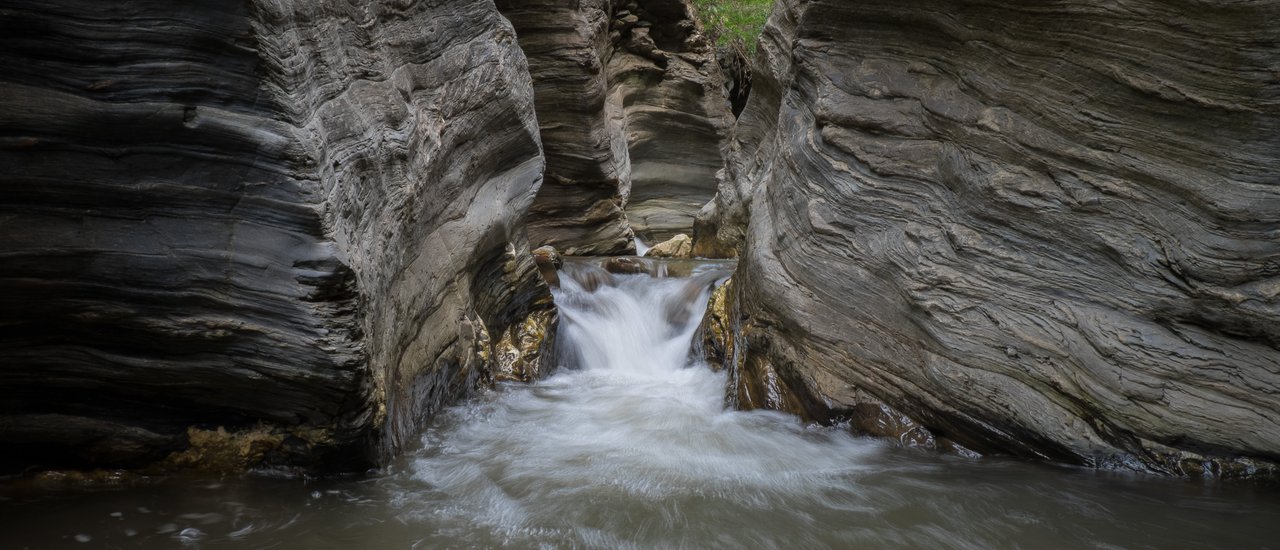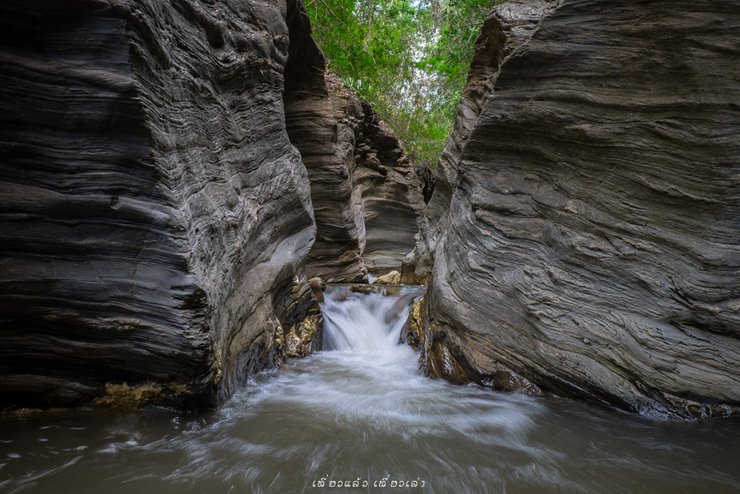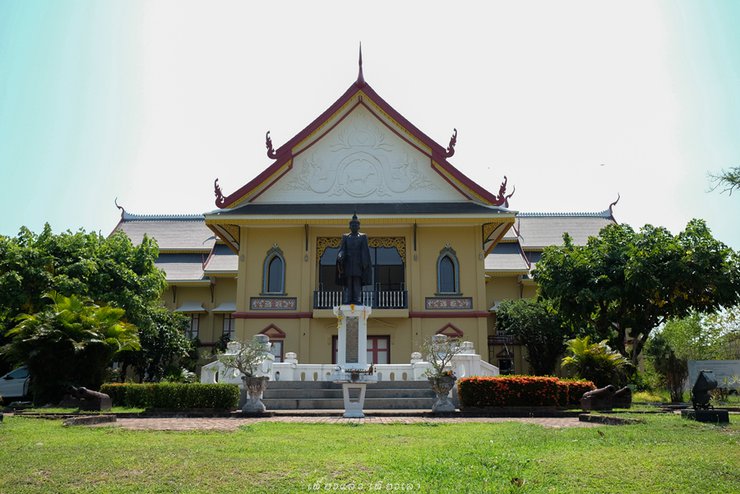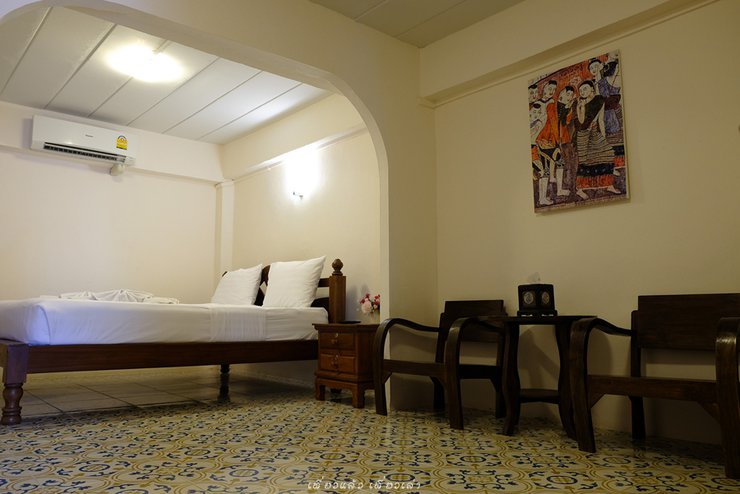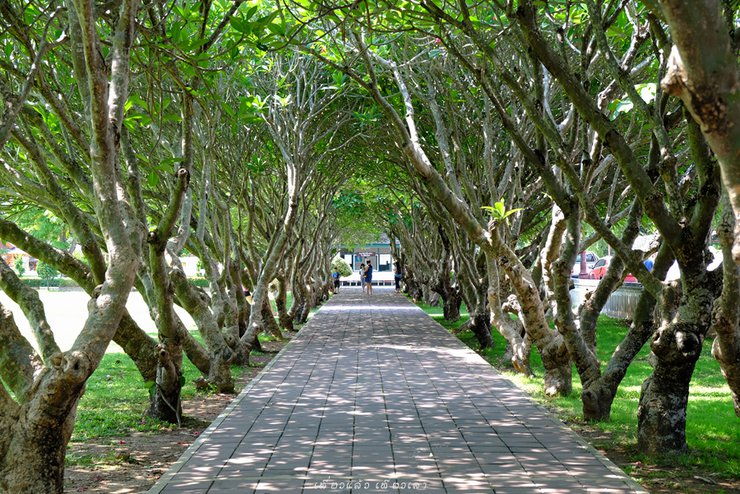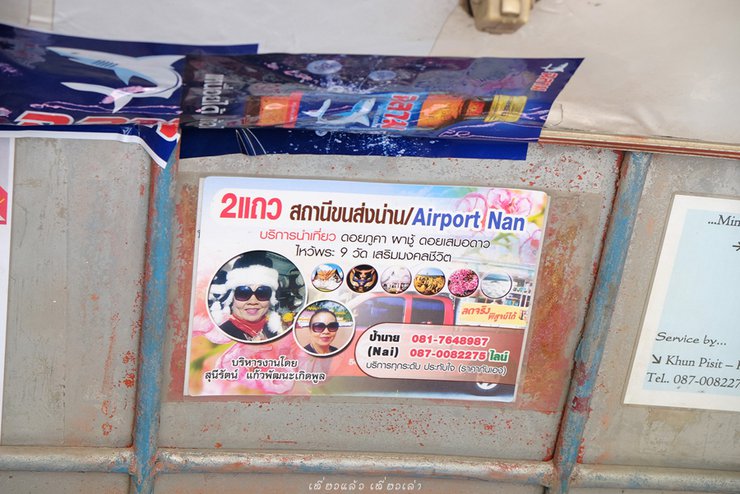

Hello again, everyone. Today, we're revisiting a special place that has left a lasting impression on us, prompting us to return time and time again. It was also the subject of our first review on Pantip: Nan Province. This charming little city, steeped in Buddhism and adorned with the beauty of Lanna culture, offers a peaceful and simple way of life that has captivated many.
This post may not contain much information, as the first review already provided sufficient details. You can click on the link below to read it.
<Travel again and again> "Whispering love in the rainy season, the charm of... N'a N'n K'r"
http://pantip.com/topic/34231650
If you have any questions or suggestions, please visit the "Travel and Tell" page. It was created to provide useful information for Thai tourism, no matter how much or how little. ^^ https://www.facebook.com/talk2travels/
"Nan" for the third time! What's so special that keeps you coming back? : I love the small town, the Buddhist way of life, the friendly people of Nan, the simplicity, the lovely and kind people of Nan, the diverse nature and tourist attractions, the food, and most importantly, the peacefulness. There are still many places in Nan that I haven't been to. This time, we are planning to visit "Wang Sila Lang", an Unseen Thailand in Pua District, Nan Province. Wang Sila Lang is most beautiful and accessible during the dry season (February-April). We traveled during May 15-17, 2016. It had started raining occasionally, but it wasn't officially the rainy season yet. The weather wasn't too hot, the water was shallow and clear, and the trees were starting to turn green. Another destination was to walk around the walking street in Nan city, which is held every Saturday and Sunday. 3 days and 2 nights, staying in the city on the first night and sleeping in Pua District on the second night. Let's travel together!
Travel
Traveling to Nan from Bangkok is convenient, with both buses and airplanes available. Alternatively, you can take a train to Den Chai District, Phrae Province, and then transfer to another vehicle. This time, I flew with AirAsia, booking during a promotion period to save money. Nok Air and AirAsia both offer flights to Nan, and they frequently have promotions.

How to travel
You can rent a car and drive yourself, rent a car with a driver, take a taxi, or take a songthaew. Everything is available at the airport. It's very convenient.
We arrived at almost nine o'clock and had booked an Avis rental car for 11 o'clock. So we took a shared taxi into town to drop off our belongings at our accommodation and wander around until it was time to pick up the car. The shared taxi that picked us up at the airport is located just outside the airport gate on the left-hand side. There will be a sign and a driver waiting to pick up customers. You can go anywhere in the city for 50 baht. If you're going further, you can negotiate the price. When it was almost time to pick up our rental car at the airport, we called the shared taxi and gave them our location so they could pick us up. The shared taxi we took is called "Auntie Nui". She is very friendly and kind and offers pick-up and drop-off services throughout Nan city. You can also hire her for trips to other districts. The price can be negotiated over the phone. You can choose where you want to stop, or you can let Auntie Nui arrange it for you. Auntie Nui's shared taxi phone number is 081-7648987,0870082275(Line).

Where to stay
There are many beautiful and affordable accommodations available, ranging from hundreds to thousands of baht. We chose to stay at "Nan Lanna" again because it is close to the walking street, within walking distance. The walking street is near Wat Hua Khuang, Wat Phra That Chang Kham, Wat Phumin, the Tourist Service Center, and the Nan National Museum.

Visit Nan Province
Most of the inner city is temples. I went to some of the places I reviewed before, due to limited time and wanting to have a leisurely and unhurried trip. There was no fixed schedule.
The "Crape Myrtle Arch" in front of the Nan National Museum is currently in full bloom, with lush green leaves contrasting against the vibrant pink flowers. Some of the flowers have already fallen, creating a picturesque scene.



"The Nan National Museum" is currently undergoing landscaping and additional building structure decoration. It will be open to the public around the end of August this year.

"Wat Noi" is the smallest temple in Thailand. It is located in front of the Nan National Museum.

"Wat Phra That Chang Kham" is located opposite the Nan National Museum.


"Wat Hua Khwang"

"Phumin Temple" is the only square-shaped ordination hall in Thailand. It looks like it is located on the back of two large nagas. The ordination hall is held in the middle of the body. In the center of the square ordination hall, there are 4 large Buddha statues in the attitude of subduing Mara, facing the doors in all four directions. It received the Outstanding Conservation Building Award from the Association of Siamese Architects in 2002.




"Phumin Temple Murals" The "Pu Man Ya Man" painting was created by an artist named Nan Buan, a local painter of Tai Lue descent. It is recognized as a masterpiece and a prominent image of Phumin Temple. It depicts a Burmese couple whispering to each other and is famously known as the "Whisper of Love, World-Renowned" painting. It has become a symbol of Nan Province, appearing in shops, hotels, resorts, restaurants, cafes, and various merchandise, including T-shirts, postcards, and even home decor items.


"Wat Phra That Khao Noi" is located on the top of Khao Noi mountain, about 240 meters above sea level. It is located in Mueang Nan district, not far from the city center. It is another important and ancient religious site in Nan province. It is believed to be the same age as Phra That Chae Haeng. As the temple is located on a high mountain, it is a beautiful viewpoint of Nan city. At the concrete courtyard, there is a large golden Buddha statue in the attitude of walking, "Phra Phuttha Maha Udom Mongkol Nanaburi Si Mueang Nan", which was built to commemorate the auspicious occasion of His Majesty the King's 6th cycle birthday (72 years old) in 1999. It is an important landmark of Nan province.
The journey up can be reached directly to the temple. Or you can walk up the 303 steps of the Naga stairs in front of the temple, which is tiring but fun.




"Wat Sri Pan Ton" boasts beautiful stucco paintings, especially the "Seven-Headed Naga King" guarding the temple's staircase, gleaming in gold. Inside the viharn, there are line drawing murals. The temple also houses a boathouse with the largest boat in Nan province, capable of holding 100 oarsmen. The temple is located opposite "Aun Nim's Sweet Shop".


"Phra That Chae Haeng", a sacred landmark of Nan province, is the designated pagoda for those born in the year of the rabbit. Currently, it is a royal temple located in Phu Phiang district, approximately 3 kilometers from the city center across the Nan River bridge.




"Wat Suan Tal" is located near the airport. Inside the temple, there is a large bronze Buddha statue in the attitude of subduing Mara, known as "Phra Chao Song Thib". The statue is 10 feet wide and 14 feet 4 inches tall. King Tilokaraj of Chiang Mai ordered its construction in 1993 to commemorate his victory over the city of Nan.


What should I eat?
"Nam ngiao - Khao soi Mae Suni" is my go-to food whenever I'm in Nan city. I always eat at the same restaurant because it's delicious and convenient. I love their khao soi, khao pad naem, and nam ngiao. "Naem Mae Suni" is also very delicious, and I always buy some to take home as a souvenir.

Coffee shop
"Kaffee Phuphayak" is highly recommended. It's our favorite coffee shop with delicious and smooth coffee. We've been there both in the morning and afternoon. It's located next to the Nan Provincial Agricultural Office and offers a variety of drinks and cakes.

"N. Nan" is a popular coffee shop that has been featured in various reviews. The owners are friendly and welcoming, and the coffee and pastries are delicious. The location on Google Maps may not be accurate, as the shop has recently moved to a new location. To get there, head towards Nan Hospital. You may get lost along the way, but you'll eventually find it. If you can't find the shop, you can call the owners for directions.




"Sweety9 shop" is housed in an old wooden building. We arrived when the shop was about to close, but the owner kindly allowed us to take a look around. Upstairs, there is a small gallery showcasing artwork. You can find it easily using Google Maps.

In the evening, we stopped by "Huat Lert Rot" restaurant for dinner and planned to walk the walking street next to Phumin Temple. But then it started to rain. We waited for it to stop, but it didn't. The rain kept drizzling. We went back to the walking street, but the market was already closed. Most of the vendors had packed up and left. Only a few restaurants were still open. In the end, we didn't get to see the walking street like we did before. We'll have to come back and visit again when we have the chance.
Visit Tha Wang Pha District
We woke up early to travel to "Wang Sila Lang" in Pua district from Nan. Take Highway 1080 Nan - Tha Wang Pha - Pua. This route passes the Nan Riverside Art Gallery. If you have time, you can stop by and visit. Read the review from the first post. We drove straight to Tha Wang Pha district and visited Wat Nong Bua, an ancient and beautiful temple in Tha Wang Pha district.

"Wat Nong Bua" is an ancient temple in Nong Bua village, Nan province. It is believed to have been built in 1862 by Khru Ba Luang Sunantah, together with the villagers of Nong Bua. This makes the temple's wihan one of the most complete examples of Thai Lanna architecture, which is very rare to find.
Another interesting thing in Wat Nong Bua is the mural painting that reflects the living conditions of the people at that time. For example, the picture of a woman wearing a beautiful "sin" skirt with a flowing water pattern or a "sin" skirt with a beautiful "tin jok". As for the mural painting in the church, it tells the story from the Pannya Jataka. It is said that the mural painting in Wat Nong Bua was painted by an artist from Nan, the same person who painted the mural painting in Wat Phumin.
In addition to its architectural and historical significance, the temple is also home to the Community Cultural Center, which produces and sells hand-woven silk skirts from Nan province. It also displays household items used by local villagers. >>> This information is from scanning the QR code on the sign in front of Wat Nong Bua as part of the ThailandScanMe project, which aims to provide more convenient access to information about tourist attractions for both Thai and foreign tourists. QR code signs have been installed at over 300 tourist attractions across Thailand.

We were impressed from the moment we got out of the car. After a while, we heard the melodious sound of local music, as if welcoming visitors. It was played by the elderly local musicians of Nong Bua village. We felt very honored and warm.


The temple is not very large, but it is beautiful and well-maintained.

Behind the temple, there is a model house of the Tai Lue community on display, which is open to the public. Next to it is the Community Cultural Center, which sells local clothes, woven fabrics, and souvenirs. There is a corner for taking cute photos and a corner for relaxing and reading books. The air is not hot, and the wind is cool and comfortable. If you are not in a hurry and stay for a long time, it is very peaceful. The toilets in Wat Nong Bua are dry and very clean.

Before leaving to say goodbye to the uncle, as he walked out of the temple, the uncle played the strings as a farewell. It was very beautiful and impressive.
Near the parking lot, there is a coffee shop and homemade cake shop. We asked the owner's permission to take pictures.


Travel to Pua District
"Mushroom Farm Baan Huay Nam Homestay"
From Wat Nong Bua, we headed to Pua District to visit Wang Sila Lang. Upon arriving in Pua, we stopped for lunch at "Mushroom Farm Baan Huay Nam Homestay". We parked our car there and walked to Wang Sila Lang. Alternatively, you can drive another way to park near the weir.

The recommended menu here is "Mushroom Pizza", which is delicious. There are also drinks available.

"Wang Sila Laeng"
After a satisfying meal, take a 500-meter walk to Wang Sila Laeng.
Accessible by car
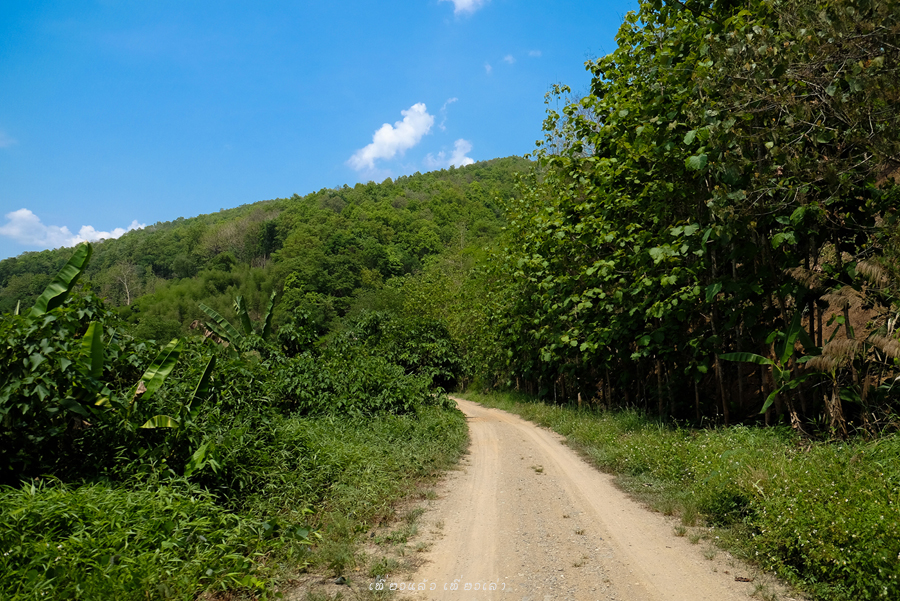
If you are driving, park near the weir and continue on foot.


Walk along the path that has been made.

There are 2 points where you can get off. You can get off at the first point and walk along the water. We got off at the first point and walked along the water with our camera. We were able to go about 100 meters before we couldn't go any further. We were afraid of dropping the camera into the water. It was also high, so we had to grab and hold onto the rocks to get through. If we came empty-handed, we would be ready to go. While we were walking along the water, the deepest point was about 130 centimeters (roughly calculated from our own height).





Wherever people go, garbage often follows. When you go on a trip, please be responsible for your own garbage. Take it back and dispose of it in the bins provided. Let's work together to keep our environment clean.
The second point, follow the water back to get a lot of beautiful angles. But we didn't walk on because we were afraid it would be cold and there would be less light in the scary forest. We got a view like this.



"Tai Lue Coffee Shop and Lam Duan Woven Fabric"
I stopped by the coffee shop for a walk. They've added a lot more seats, so I guess they're getting more customers. But I went in the evening and there was no one there, and the shop was about to close.






"Phuket Temple"
The view is beautiful during the rice planting season. You can read more about it in the first review. [Spoil] Click to see hidden texthttp://pantip.com/topic/34231650





Phuket Temple also has a "Dikdeium tree". The tree is still young. At first, we thought that Amphoe Pua only had Dikdeium trees at Wat Prang. We happened to find it at Phuket Temple. We must thank our fellow travelers who are observant. "Dikdeium tree" is a magical tree. When touched on the trunk, the top of the leaves will tremble as if being tickled. It's strange. The monk demonstrated stroking the Dikdeium tree for us to see.



"Jay Toi Pad Thai"
We then had dinner at "Jay Toi Pad Thai" restaurant. The taste was good. I liked the crispy pork with salt. They have both savory and sweet dishes, fresh coffee, various drinks, and even bingsu. However, I didn't try the bingsu.


"Pink Phu Kha Resort @ Pua"
Tonight we are staying at "Chompoo Phuka Resort", located in the center of Pua town on a high hill with a view of Pua town. It is next to the R.S. 200 Reservoir Public Park. Chompoo Phuka Resort offers rooms at affordable prices. There is also a restaurant and live music in the resort, but the sound does not disturb our room. We slept comfortably. The room is clean.


We stayed in a standard room for 600 baht/night. The room has air conditioning and includes breakfast. There are many types of rooms available. During the high season, the room rate will increase by 100 baht. Overall, I am impressed.

Breakfast options include rice porridge or fried egg with rice. Bread, fruit juice, and coffee are available for self-service. There are also adorable dogs to welcome guests.

There are viewpoints.

View of Pua City

View of the Ang Kaew Reservoir Park, established in 1957

"Prang Temple"
After checking out, we traveled to "Wat Prang" not far away to see another "Dikdeam tree". The Dikdeam tree here is very old.


"Wat Ban Ton Laeng"
"Wat Ton Laeng" is a Lanna-style temple built by the first generation of Tai Lue people who migrated from Sipsong Panna. It is located not far from Wat Prang.


"Wat Phra That Beng Sakat"
We returned to the town of Pua to pay homage to Phra That Beng Sakat, the temple that is a symbol of Pua district. This chedi is a Lanna architecture built by Phraya Phuka in 1826, before the construction of the viharn. It has been renovated by kings of the Nan dynasty for many generations. Inside the temple, there is an important ancient site, the Phra That Beng Sakat, which enshrines the relics of the Lord Buddha for over 700 years. It has been a sacred object of Pua for a long time. This temple was declared a national ancient monument in the Royal Gazette on October 24, 1944.


"Phraya Phan Ngoen Monument"
Located in front of the Pua District Office, Moo 5, Woranakhorn Subdistrict, is a monument to the former city lord, a brave hero who restored independence from Phraya Ngam Mueang, the city lord of Phayao.

View of Pua town at 10 am

We then traveled back to Nan city to catch a flight back to Bangkok. On the way, we stopped at the Royal Rice Mill in Tha Wang Pha district, where there is a coffee shop called Phu Pha Yak and a souvenir shop.
"Royal Rice Mill"


"Sanan flies to Nannakorn"

The airport has some cute souvenir shops.




I'm back. Nan is still as lovely and impressive as ever. I will definitely come back to visit again. I hope the Nan forest will return to its lush green state soon. See you again... Hello.
The cost of this trip is approximately four thousand baht.
เที่ยวแล้ว เที่ยวเล่า
Friday, September 27, 2024 10:08 AM

